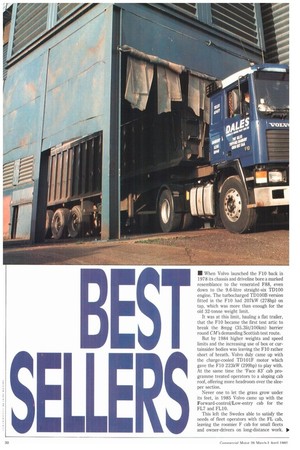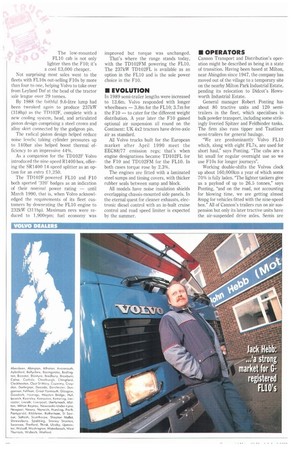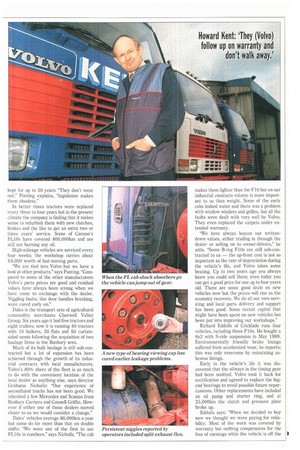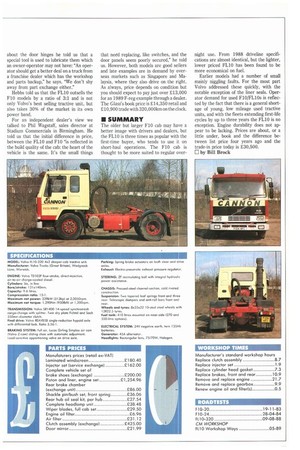13 E
Page 32

Page 34

Page 35

Page 36

Page 37

If you've noticed an error in this article please click here to report it so we can fix it.
SELLE
• When Volvo launched the FIO back in 1978 its chassis and driveline bore a marked resemblance to the venerated F88, even down to the 9.6-litre straight-six TD100 engine. The turbocharged TD100B version fitted in the FIO had 207kW (278hp) on tap, which was more than enough for the old 32-tonne weight limit.
It was at this limit, hauling a flat trailer, that the F10 became the first test artic to break the 8mpg (35.3lit/100km) barrier round CM 's demanding Scottish test route.
But by 1984 higher weights and speed limits and the increasing use of box or curtainsider bodies was leaving the F10 rather short of breath. Volvo duly came up with the charge-cooled TD101F motor which gave the F10 223kW (299hp) to play with. At the same time the 'Face 83 cab programme treated operators to a sloping cab roof, offering more headroom over the sleeper section.
Never one to let the grass grow under its feet, in 1985 Volvo came up with the Forward-control/Low-entry cab for the FL7 and FL10.
This left the Swedes able to satisfy the needs of fleet operators with the FL cab, leaving the roomier F cab for small fleets and owner-drivers on long-distance work. The low-mounted FL10 cab is not only lighter then the F10; it's a cool £3,000 cheaper. Not surprising most sales went to the fleets with FL1Os out-selling FlOs by more than four to one, helping Volvo to take over from Leyland Daf at the head of the tractor sale league over 29 tonnes.
By 1988 the faithful 9.6-litre lump had been tweaked again to produce 237kW (318hp) as the TD102F, complete with a new cooling system, head, and articulated piston design comprising a steel crown and alloy skirt connected by the gudgeon pin.
The radical piston design helped reduce noise levels; taking cylinder pressures up to 140bar also helped boost thermal efficiency to an impressive 44%.
As a companion for the TD102F Volvo introduced the nine-speed R1400 box, offering the SR1400 14-speed splitter as an option for an extra .Y..1,250.
The TD102F-powered FLIP and F10 both sported '320' badges as an indication of their nominal power rating — until March 1990, that is, when Volvo acknowledged the requirements of its fleet customers by downrating the FL10 engine to 232kW (311hp). Maximum revs were reduced to 1,900rpm; fuel economy was improved but torque was unchanged.
That's where the range stands today, with the TD102FM powering the FLIO. The 237kW TD102FL is available as an option in the FLIO and is the sole power choice in the Flo.
• EVOLUTION
In 1989 semi-trailer lengths were increased to 13.6m. Volvo responded with longer wheelbases — 3.8m for the FL10; 3.7m for the F10 — to cater for the different weight distribution. A year later the F10 gained optional air suspension all round on the Continent: UK 4x2 tractors have drive-axle air as standard.
All Volvo trucks built for the European market after April 1990 meet the EEC88/77 emission regs; that's when engine designations became TD102FL for the F10 and TD102FM for the FL10. In both cases torque rose by 2,3%.
The engines are fitted with a laminated steel sumps and timing covers, with thicker rubber seals between sump and block.
All models have noise insulation shields overlapping chassis-mounted side panels. In the eternal quest for cleaner exhausts, electronic diesel control with an in-built cruise control and road speed limiter is expected by the summer.
• OPERATORS
Cannon Transport and Distribution's operation might be described as being in a state of transition. Having been based at Milton, near Abingdon since 1947, the company has moved out of the village to a temporary site on the nearby Milton Park Industrial Estate, pending its relocation to Didcot's lowsworth Industrial Estate.
General manager Robert Ponting has about 80 tractive units and 120 semitrailers in the fleet, which specialises in bulk powder transport, including some strikingly liveried Spitzer and Feldbinder tanks. The firm also runs tipper and Tautliner semi-trailers for general haulage.
"We are predominantly Volvo FL10 which, along with eight FL7s, are used for short haul," says Ponting. "The cabs are a bit small for regular overnight use so we use FlOs for longer journeys".
Working double-shifts the Volvos clock up about 160,000km a year of which some 70% is fully laden. "The lighter tankers give us a payload of up to 26.5 tonnes," says Ponting, "and on the road, not accounting for blowing time, we are getting almost 8mpg for vehicles fitted with the nine-speed box." All of Cannon's trailers run on air suspension but only its later tractive units have the air-suspended drive axles. Semis are kept for up to 20 years: "They don't wear out," Ponting explains, "legislation makes them obsolete."
In better times tractors were replaced every three to four years but in the present climate the company is finding that it makes sense to refurbish them with new clutches, brakes and the like to get an extra two or three years' service. Some of Cannon's FL 10s have covered 800,000Iun and are still not burning any oil.
High-mileage vehicles are serviced every four weeks: the workshop carries about g8,000 worth of fast-moving parts.
"We are tied into Volvo but we have a look at other products," says Ponting. "Compared to some of the other manufacturers Volvo's parts prices are good and residual values have always been strong when we have come to exchange with the dealer. Niggling faults, like door handles breaking, were cured early on," Dales is the transport arm of agricultural commodity merchants Cherwell Valley Group. Six years ago it had five tractors and eight trailers; now it is running 40 tractors with 10 bulkers, 30 flats and 50 curtainsided semis following the acquisition of two haulage firms in the Banbury area.
Much of its bulk haulage is still sub-contracted but a lot of expansion has been achieved through the growth of its industrial contracts with local manufacturers. Volvo's 80% share of the fleet is as much to do with the convenient location of the local dealer as anything else, says director Grahame Nicholls: "Our experience of secondhand trucks has not been good. We inherited a few Mercedes and Scanias from Banbury Carriers and Connell Griffin. However if either one of those dealers moved closer to us we would consider a change."
Dales' vehicles average 80,000km a year but some do far more than that on double shifts: "We were one of the first to use FLA Os in numbers," says Nicholls. "The cab makes them lighter than the F10 but on our industrial contracts volume is more important to us than weight. Some of the early cabs leaked water and there was a problem with window winders and grilles, but all the faults were dealt with very well by Volvo. They even replaced the carpets under extended warranty.
"We have always beaten our writtendown values, either trading in through the dealer or selling on to owner-drivers," he adds. "Some B-reg FlOs are still sub-contracted to us — the up-front cost is not so important as the rate of depreciation during the vehicle's life, and Volvo takes some beating. Up to two years ago you always knew you could sell them; even today you can get a good price for one up to four years old. There are some good deals on new vehicles now but the prices will rise as the economy recovers, We do all our own servicing and local parts delivery and support has been good. Some recent capital that might have been spent on new vehicles has been put into improving our workshops."
Richard Eddolls of Cricklade runs four vehicles, including three Fl Os. He bought a 6x2 with S-ride suspension in May 1989. Environmentally friendly brake linings suffered from accelerated wear, he reports; this was only overcome by reinstating asbestos linings.
Early in the vehicle's life it was discovered that the oilways in the timing gear had been omitted. Volvo took it back for rectification and agreed to replace the bigend bearings to avoid possible future repercussions. Other replacements have included an oil pump and starter ring, and at 25,000km the clutch and pressure plate broke up.
Eddolls says: "When we decided to buy new we thought we were paying for reliability. Most of the work was covered by warranty but nothing compensates for the loss of earnings while the vehicle is off the road. One vehicle down in a fleet of 40 may be inconvenient — one in four is a major disaster." The core business for Howard Kent Transport is vegetables and fruit, with backloads of finished products delivered to supermarket chains.
Demand is seasonal so the fleet size varies. At present 22 Volvos operate out of Welney, Cambs. In 1985 the family concern switched to Volvos: "We haven't seen an ERF salesman since although we were 100% with them at one time," says Howard Kent, He appreciates the FL10's low unladen weight, but points out that the air suspension on later models offsets this. Nonetheless he reckons that they're sensibly designed, giving protection in damage-prone areas; the bumper is in three parts and the rear lights unplug.
"Spares are readily available which reduces the risk element in servicing," he adds. "The difflock is standard and we need it for rural work — it's a £1,000 extra on some vehicles."
Kent has no fixed policy on age when replacing or adding to the fleet, but with a workshop working two shifts he reckons that he gets good value from the vehicles he refurbishes.
Apart from the fact that the nearest dealer is an hour's drive away, it can't match his in-house costs when tendering for contract maintenance deals. Refurbishment makes Kent keenly aware of parts prices: "Volvo is much more expensive than factors," he says, pointing to a turbocharger which costs £70 less from Holset.
Kent operates FL1Os locally and FlOs on long-haul work; since imposing his own SOmph speed limit fuel consumption has improved without a serious effect on overall journey times: "The FL1Os are about 1mpg better than the FlOs which give 7mpg," he says, "and on an average of 70,000 miles (112,000km) a year, using our own bunkering, each one saves me £1,750. But the spin-off is a longer life for tyres and brakes.
"Volvo promised me half a mile per gallon more from the latest FL10320," he adds. "I didn't get it at first so they came back and adjusted the fuel pump. On a short assessment it looks like we are getting over 9mpg. Buying new now should offer good residuals in three to four years' time — Volvo has its finger on the pulse where parts modifications are needed. They follow up on warranty and don't walk away."
Kent thinks that the cabs shape up well, but he has had problems with distorted trim on the older FL1Os and says "you know when the FL cab's shock absorbers have gone — the vehicle jumps out of gear. They cost about £120 each but usually only the rear ones have to be replaced."
Other problems have included split exhaust flex, broken door handles, stiff door hinges and, on older models, the front axle oil level viewing glass can be melted by the heat of the brakes "but I only remember fitting one propshaft Ui in the past six years," he adds.
Kent also wonders why it is that paint, fifth wheels, run up ramps and suzies — all necessary to a vehicle's operation — are not standard fittings when the catwalk, coupling light and night heater are factory fitted.
• DEALER
John Hebb was one of the first three Volvo franchises to be awarded by Jim McKelvie in 1967. It extends from South Humberside to Lincolnshire and even in a recession Jack Hebb will sell 200 used trucks and as many new ones in a year. In a good year that number can double.
On the day we arrived at the dealership near Scunthorpe there were 197 used Volvos including 50 FL1Os in stock. Hebb told us: 'There is a strong market for G-registered FL1Os, they are very difficult to get hold of and they hold their price. We have just sold a 1989 F-reg tractive unit, in the operator's colOurs and ready to go, for £18,000, which is well over book. Older tractive units are not sticking either but 8x4s are a bit slow."
Unusually for this time of the year he has had a big demand for tipping trailers. Hebb agreed that door handles had been a problem in the past and checked to see how many he had sold recently: "Only a dozen in the past three months," he told us.
The TD101F engine, used on Fl Os from 1983 and FL1Os through to the end of 1987, has a problem with top liner seals which was rectified on later TD102F units, If the engine set is replaced it will give about three years' operation without further attention, he says.
Vehicles operating over bumpy country roads are more prone to cab suspension wear and exhaust cracking. When asked about the door hinges he told us that a special tool is used to lubricate them which an owner-operator may not have: "An operator should get a better deal on a truck from a franchise dealer which has the workshop and parts backup," he says. "We don't shy away from part exchange either."
Hebbs told us that the FL10 outsells the F10 models by a ratio of 3:1 and is not only Volvo's best selling tractive unit, but also takes 30% of the market in its own power band.
For an independent dealer's view we talked to Phil Wagstaff, sales director at Stadium Commercials in Birmingham. He told us that the initial difference in price, between the FL10 and F10 "is reflected in the build quality of the cab: the heart of the vehicle is the same, It's the small things that need replacing, like switches, and the door panels seem poorly secured," he told us. However, both models are good sellers and late examples are in demand by overseas markets such as Singapore and Malaysia, where they also drive on the right. As always, price depends on condition but you should expect to pay just over £13,000 for an 1989 F-reg example through a dealer. The Glass's book price is £14,350 retail and £10,900 trade with 320,000km on the clock.
• SUMMARY
The older but larger F10 cab may have a better image with drivers and dealers, but the FLIO is three times as popular with the first-time buyer, who tends to use it on short-haul operations. The F10 cab is thought to be more suited to regular over night use. From 1988 driveline specifications are almost identical, but the lighter, lower priced FL10 has been found to be more economical on fuel.
Earlier models had a number of small mainly niggling faults. For the most part Volvo addressed these quickly, with the notable exception of the liner seals. Operator demand for used FlO/FL1Os is reflected by the fact that there is a general shortage of young, low mileage used tractive units, and with the fleets extending first-life cycles by up to three years the FL10 is no exception. Engine durability does not appear to be lacking. Prices are about, or a little under, book and the difference between list price four years ago and the trade-in price today is £30,500.
El by Bill Brock




























































































